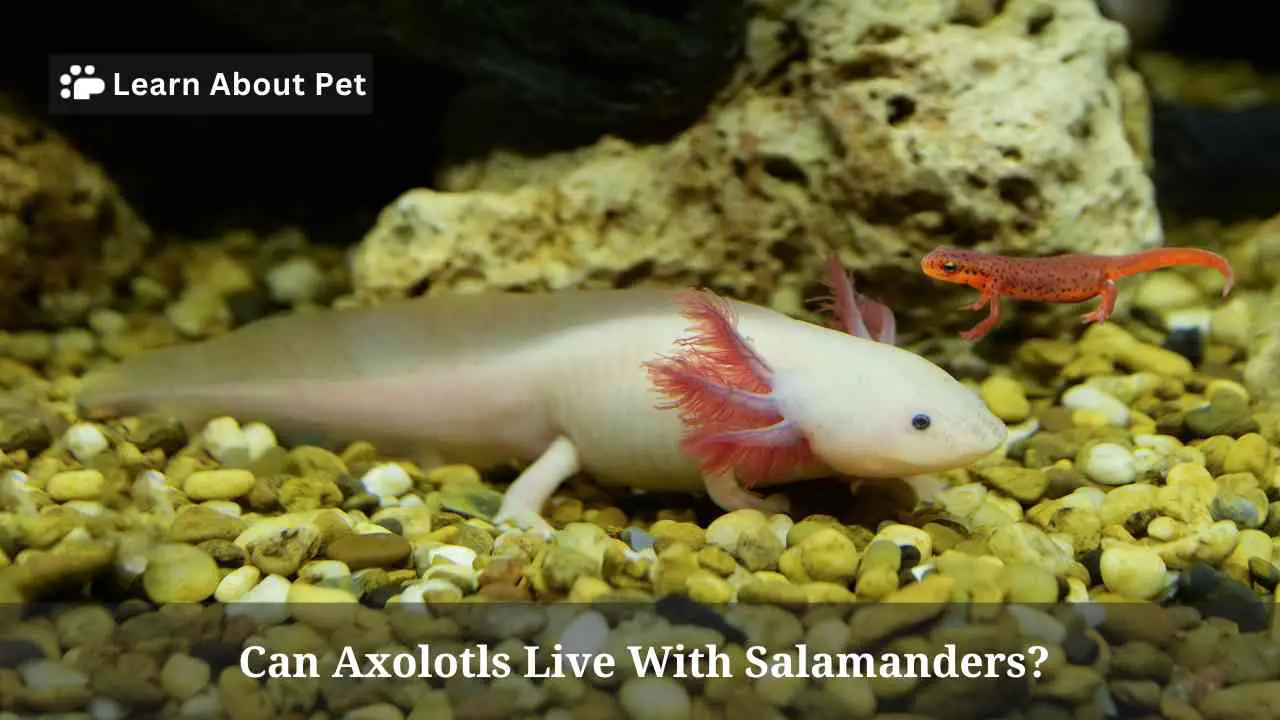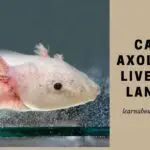The axolotl is known as the Mexican walking fish. It is a salamander that has become increasingly popular in recent years. It’s kept for scientific research and as a pet because the population continues to decline. Only less than a hundred are in the wild now.
Since axolotls are salamanders, you might be wondering if Axolotls can live together with Salamanders.
Can axolotls live with salamanders? It’s not recommended to put tiger salamanders with axolotls in one tank, even though they are very closely related. Axolotls are solitary animals that can potentially harm their tank mates if their needs are not met. In addition, terrestrial tiger salamanders cannot live with aquatic axolotls.

We must find out why the axolotl can’t live together with other salamanders. Let’s find out in this article.
Are Axolotl Salamanders?
The axolotl is a species of salamander with a unique genetic makeup. Axolotls are neotenic, which means they retain the characteristic that can only be seen in younger animals. If other salamanders can live on land and lose their gills as adults, axolotls keep them and live on the water forever.
Physically, the axolotl is a salamander that cannot develop and stays in its juvenile body form. While other salamanders need tanks with ground space, the axolotl needs tanks with full water.
Can Axolotls Live With Salamanders?
Axolotls need large tanks to complete their needs. If you want to give tankmates, try the tiger salamander, which is closely related to the axolotl.
But these two animals are not recommended to be in the same place because they can be very aggressive to each other, one of them can eat a smaller size, and there is still the possibility of attacking each other even though they are the same size.
Axolotls can be aggressive if they are underfed or stressed because their requirements do not match. Terrestrial tiger salamanders cannot live in water when they are adults. In contrast to axolotls which remain in the water and will not live on land like other salamanders.
Can Axolotls Live With Salamanders In The Wild?
Wild axolotls live in the swampy remnants of the lake. If they were in the same place as other salamanders, they could bump into each other and attack each other. Axolotls are predators that will eat anything smaller than them.
Right now, the axolotl’s natural habitat is drastically reduced. You can no longer analyze how wild axolotls live with other salamanders.
Many axolotl owners kept it for scientific research, but they chose to keep the axolotl in the tank alone. No one took the risk of putting in a salamander and axolotl because there was a high chance that the two would attack each other.
Can Axolotls And Salamanders Be Interbred?
Tiger salamanders are salamanders that can interbreed with axolotls while in captivity. Axolotls are closely related to salamanders and can produce viable offspring together.
After the tiger salamanders enter the adult stage, they leave the water and live on land. If you buy an axolotl in a pet store, you won’t expect to get the same axolotl as in the wild because it is interbred with tiger salamanders.
Can Axolotls Become Salamanders?
Axolotls are technically salamanders, but they are aquatic like fish. The difference between axolotls and other salamanders is that they never metamorphose and stay in their juvenile body. Axolotls will not leave water or gills because they need them to live underwater for the rest of their lives.
The body shape and characteristics are similar to the tiger salamander, but the axolotl has an unnatural metamorphosis and a shorter lifespan. Many try to put juvenile tiger salamanders together with axolotls in one tank.
If there are no signs of aggression, there will be no problem keeping both axolotl and tiger salamander until the tiger salamander enters the adult stage.
How Long Does It Take For An Axolotl To Turn Into A Salamander?
Axolotls are neotenic salamanders that never undergo metamorphosis. They will retain their characteristics and stay in the juvenile body for the rest of their lives. In contrast to their closely related salamanders like tiger salamanders, which begin to leave the water after entering the adult stages.
If you wait for the axolotl to enter the adult stage and leave the water, you will never see it. Axolotls will not metamorphose like normal salamanders and will remain in their juvenile phase until the end of their lives.
Are Axolotls Related To Salamanders?
Yes, the axolotl is a salamander species with a unique genetic makeup. Axolotls have a rare condition called neoteny, and they remain at a specific stage even though they are fully mature. Axolotls retain their larval features like feathery gills and long dorsal fins for life.
Axolotls cannot live on land like other salamanders that have entered the adult stage. They include salamanders of the family Ambystomatidae as permanent retention of larval features.
Why Do Some Axolotls Turn Into Salamanders?
It’s possible to force axolotls to enter metamorphosis, but the process is unnatural and shortens their lifespan. Axolotls are similar to tiger salamanders, but they don’t naturally morph. Forcing axolotls to morph will harm their conditions.
You can force the axolotl to become an adult salamander with iodine injection. They only live a short time on land and will not be able to like other salamanders in the wild.
The injection process not only shortens their life, but the condition of an aquatic pet will never be fine when forced to live on land.
What Best Animal To Live With Axolotls?
The best option for giving tankmates to axolotl is another axolotl. But you have to adjust their size because axolotls can be aggressive to smaller sizes. The table below is another option for the best animals that live with axolotls.
| Best animals with axolotl | Explanation |
| White cloud mountain minnows | Peaceful cool water fish with lack of spines and shells. |
| Guppy fish | Rarely poses a risk to axolotls and often used as feeder fishes. |
| Zebra danios | Agile fish and mostly stay away from axolotl. |
| Apple snails | Soft shells, move slowly, and enough for axolotl to eat. |
Do Axolotls Eat Salamanders?
Axolotls will eat anything that can fit inside their mouth. They will eat their prey by swallowing it whole including other salamanders. Axolotls grasp their prey with their teeth. Axolotls cannot tear prey because their teeth are not sharp or strong.
Placing other axolotls or salamanders can cause one of them to be aggressive. If big axolotls are hungry and there is not enough food, they will eat their tankmates with smaller bodies.
Axolotls are better off living in a tank alone without tankmates and they will never get bored with those conditions.
Is It Dangerous To Bring Axolotls And Salamanders In The Same Tank?
Juvenile salamanders can remain in the water until they metamorphose. If they are the same size and the tank has enough space, the axolotl and other salamanders will not cross paths often because they can swim and have their area.
But if the axolotl and salamander are often close together, or one of them is under stress, then aggressive behavior is inevitable. It is not recommended to mix axolotls with other axolotls as they can be aggressive with each other.
Final Verdict
Axolotls are solitary animals that are better off not having tankmates. Terrestrial tiger salamander is a salamander that is very closely related to the axolotl. Juvenile tiger salamanders can stay in an axolotl tank until they are adults and must leave the water.
Both tiger salamanders and axolotls can act aggressively with each other and one of them may be eaten. Even if you put tiger salamanders and axolotls of similar sizes, you can’t avoid their aggressive behavior.

Welcome to Learn About Pet. My name is Rajkumar Ravichandran and I love all pets, travel, and amazing food. I write about my passion and personal experience caring for multiple pets in this blog! ❤️
Post Disclaimer
DISCLAIMER: THIS BLOG OR WEBSITE, "Learn About Pet", DOES NOT PROVIDE YOU WITH MEDICAL ADVICE AND IS NOT A SUBSTITUTE FOR MEDICAL ADVICE. ALWAYS GET IN TOUCH WITH YOUR PERSONAL VETERINARIAN AND USE INFORMATION HERE AS GENERAL ADVICE.
The information, including but not limited to, text, graphics, images and other material contained on this website are for informational purposes only. No material on this site is intended to be a substitute for professional veterinary advice, food recommendation, diagnosis, or treatment. Always seek the advice of your veterinarian or other qualified health care provider with any questions you may have regarding a medical condition or for pet food related questions.







